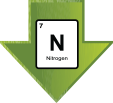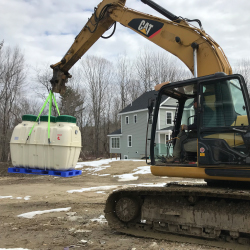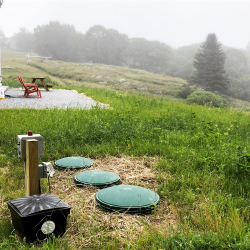FAQs for Homeowners
What is Fuji Clean?
Fuji Clean is the world’s oldest advanced wastewater treatment system with over 3 million systems in the ground worldwide and hundreds more right here in Maine!
Why do I need an advanced wastewater treatment system?
Typically local regulations and soil conditions of your unique home site may dictate the need for a treatment (sometimes called “pretreatment”) system. A typical septic system accepts wastewater from your home, cleans it and sends clean water back to the environment (usually into a soil absorption system such as a leach field). The advantage of this process is that our Fuji systems provided by Maine Septic Solution do the purification work ordinarily accomplished by the soil. This allows for much smaller, shallower and less obtrusive drain fields taking up space in your yard. Additionally, pretreatment greatly extends the life of a drain field since clean water deters solids and biological buildup (biomat) in your leach field. In some regions of Maine, treatment is required to reduce by products of wastewater, some of which are harmful, such as nitrogen from your wastewater stream which protects against contamination of nearby water bodies and aquifers.
We have a septic system is installed on our vacation home and wondering if we should turn it off when we are not home?
Our systems are designed to accommodate variable and intermittent flows – whether you have a multitude of guests visiting your Vacationland getaway or if you just need it for weekend use. Since the systems air blower operates continuously, regardless of inflow, it can be shut down for seasonal properties if the system is not going to be used for an extended period of time. Ideally the blower should be re-started at least three days in advance of re-engaging the system.
What if there is a power outage?
During a power outage, the blower will cease operation and after about twenty-four hours treatment quality will begin to diminish. However, your system will still allow wastewater to pass through and will not create a backup in the house. (Unless a separate pump station has been installed.)
Does my septic system need servicing?
Maine Septic Solution provides systems designed to require minimal service. To ensure proper operation we recommend an inspection and service every six months during the first two years of use. Your system’s extended service policy mandates semi-annual inspection or service visits from a trained and certified provider. (This schedule may be amended for seasonal and part-time use).
Does my system need to be pumped out?
Like an ordinary septic tank, sludge must be removed from your system periodically (typically once every two to four years). Maine Septic Solution is happy to provide guidance for you on this and if necessary we can help to arrange for a septic tank pumping company to provide this service. Pump-out frequency depends on waste stream volume and use. We are happy to offer our customers information to determine the frequency that is best for you.
How much will it cost in electricity to run my system?
A CE5 or CEN5 treating 450 gallons per day is about 15.6 cents per day or $56.80 per year.
Can I use a garbage disposal with my system?
Unfortunately no. Garbage disposals are never recommended with any septic systems.
Is there anything that I should definitely not put into the system?
Your new system is a living culture, you should avoid flushing or draining toxic materials into the system such as paint, household chemicals and antibiotic medicines as they can harm the natural bacterial action that is ideal for optimal operation. Other items to avoid flushing into the system include bulky or non-biodegradable materials such as sanitary napkins, paper towels and cigarette butts. We also recommend avoiding excessive cooking grease, and coffee grounds be disposed of through your compost/recycle/solid waste stream instead of though your treatment system.
What if I need to disinfect a well?
On occasion, a contaminated well needs to be disinfected (usually with bleach). If you need to do this, do not run the chlorinated water through your septic system. Instead, open the outside water faucets and let the water run for several hours or as long as necessary to flush the chlorine out of the well. It’s advised to avoid using water inside the house during this process.
Will toilet additives help my system?
Absolutely not! Toilet tablets and drain-clean products will generally deplete necessary bacteria from the system. Products that advertise drain field health are typically unhelpful to the system and often temporarily emulsify fats, oils and greases, only to re-coagulate after they reach the drain field.
What if I hear the alarm?
Your alarm/control panel monitors all the important functions of your septic system. An alarm (both audio and visual) will be triggered in the rare event of a problem, such as water is not being discharged from the system or your air blower is not operating properly. In the event of an alarm condition, go to the control panel, find the toggle switch on the outside right and push toward “silence.” This will mute the audio alarm, although the visual alarm light will remain lit. Next, contact Water Quality & Compliance at 207-882-5476.
What would you recommend for cleaning products?
As a general rule, the more natural the cleaning product the better. Synthetic surfactants designed for toilet bowls for example, often contain chemicals, synthetic dyes, chlorine bleach, ammonia, petroleum-derived ingredients, and other harmful ingredients, such as Triclosan (prevents mold growth) that are incompatible and hazardous to a healthy bacterial ecosystem living within your system. Ideal choices might include white vinegar, Borax, or other citric acid based cleaners.
FAQs for Professionals
Your specifications list two airlift pumps (one recirculation and one discharge). Can the discharge airlift pump deliver pressurized effluent to a subsurface disposal system?
No. Both airlift pumps use pressurized air (from the blower) to carry water via ascending bubble fluid pressure. The discharge airlift pump lifts treated effluent from the treatment tank but depends on gravity to carry it to a subsurface disposal system. You must specify a separate discharge pump for pumping effluent if a head is necessary.
How are systems sized for higher strength effluent streams?
Our standard hydraulic sizing assumes domestic strength influent (i.e. about 250 mg/L BOD and 150 mg/L TSS). Models to treat higher strength waste streams are upsized linearly based on organic loading strength.
Does the air diaphragm blower operate constantly?
Yes. Air blower operation is independent of hydraulic flow.
Do you have any data on blower noise emission?
Yes. Decibel levels are provided in the table below. In general, noise from the MACBlower “R” series line places Fuji Mac blowers as best-in-class category. (Please refer to the O&M Manual for blower sizing information.) Most residential units use a MAC80R air blower.
|
MACBlower Model |
Operating Decibels |
|
MAC40R |
40 dB |
|
MAC60R |
42 dB |
|
MAC80R |
40 dB |
|
MAC100R |
42 dB |
|
MAC120R |
41 dB |
|
MAC150R |
44 dB |
|
MAC200R |
45 dB |
Do you have data for tank buoyancy calculations?
The following table provides empty tank buoyancy information for Fuji Clean residential system models. As stated in the Installation Manual, for high groundwater sites we recommend anchoring the tank using precast concrete anchors (deadman) and 1 inch galvanized coated strapping or equivalent. Set deadman 12” away from tank. Please do not use lifting lugs with turnbuckles to anchor tank
Empty Tank Buoyancy:
Model CE5: 5,270 Lbs.
Model CE7: 7,210 Lbs.
Model CE10: 10,400 Lbs.
Model CEN5: 7,210 Lbs.
Model CEN7: 10,400 Lbs.
Model CEN10: 14,500 Lbs.
Do you have sludge accumulation data?
Our best long term sludge accumulation data determined that the average time to reach pumpout depth is every 4 years. We require that sludge be measured every 6 months along with a service visit. As directed in the O&M Manual, septic system pump out should occur when sludge levels reach 24” in the sedimentation chamber (first chamber) or 18” in the anaerobic chamber (middle chamber). Based on “normal” full time household water use, we therefore recommend pump out once every 2 years with higher frequency for higher hydraulic or organic strength flows – particularly if a garbage disposal is being used.
Do you offer control panels with wi-fi capabilities?
Yes. Contact us for more information.
What is your typical start-up time?
Assuming a recommended start-up configuration (2/3 clean water, 1/3 septic), our systems achieve NSF 40 standards within 1 week of operation, understanding that there are many variables that contribute to start-up performance.
Do you have design recommendations for highly variable flows?
Our systems are uniquely customizable and designed to accommodate variable flows. This is due in large part due to the recirculation airlift pump which has a built in mechanism for leveling variable flows which maximizes retention time and treatment. For extreme variable flows (such as in a church where there is a very large peak flow one day a week), we recommend the installation of a preceding settling tank large enough to accommodate total peak flow and then metering flow incrementally to the system throughout the unused periods.
Should any design precautions be made for cold climate environments?
Yes. As noted in the Installation Manual, we recommend insulating the upper half of the system tank, discharge pump (if applicable), discharge line and D-box for all installations in cold climate environments. Recommended insulation is 2 inch rigid foam board (R-10 insulating factor) covering the system and about 6” over discharge lines to stop frost penetration into the ground.
Can systems be clustered to accommodate larger flows?
Yes. Please contact us for additional details and engineering assistance if necessary.
What is your NSF status?
We have successfully completed NSF/ANSI 40 and NSF/ANSI 40 & 245 testing. A summary of results is available in our technical specifications.
Can you deliver verifiable single digit BOD and TSS performance?
Yes. Our CEN model line (tested for NSF/ANSI 40 & 245) will provide single digit BOD and TSS results (as well as highest quality TN removal) with domestic strength wastewater as demonstrated in NSF testing. A summary of NSF testing results is available in our technical specifications.

BEST OPTION FOR THE ENVIRONMENT

INDUSTRY LEADING NITROGEN REDUCTION

CERTIFIED TO NF/ANSI STANDARDS 40 & 245







